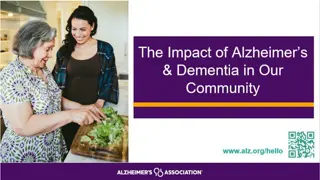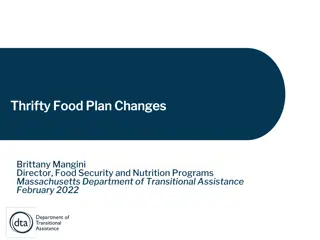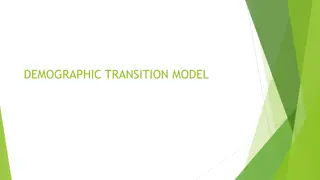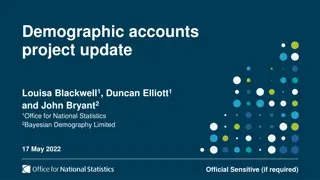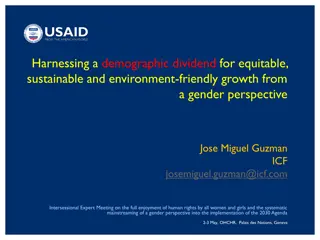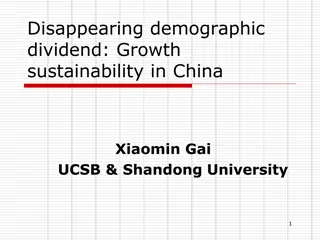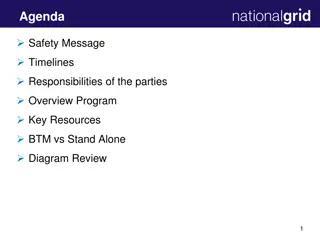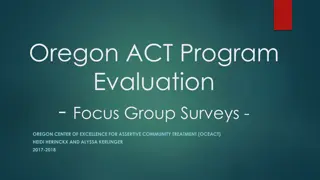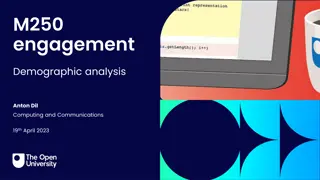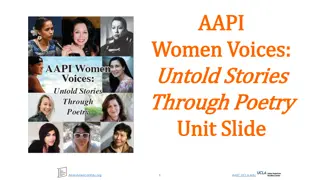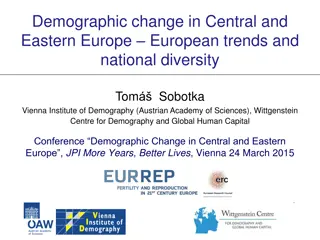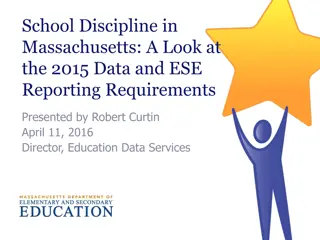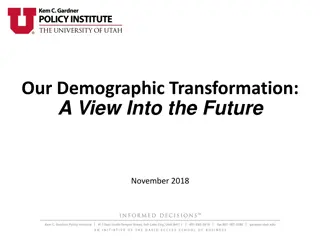Demographic Overview of AAPI Communities in Massachusetts
Greater Boston has seen significant population growth driven by immigrants of color, with Asian Americans being the fastest-growing racial group. The Asian population in Greater Boston is similar in size to African American and Latinx populations. More than two-thirds of Asian Americans in Greater Boston are foreign-born. Asian American immigrants come to the U.S. through various channels, with notable countries of origin being India, South Korea, China, Nepal, and Vietnam.
Download Presentation

Please find below an Image/Link to download the presentation.
The content on the website is provided AS IS for your information and personal use only. It may not be sold, licensed, or shared on other websites without obtaining consent from the author.If you encounter any issues during the download, it is possible that the publisher has removed the file from their server.
You are allowed to download the files provided on this website for personal or commercial use, subject to the condition that they are used lawfully. All files are the property of their respective owners.
The content on the website is provided AS IS for your information and personal use only. It may not be sold, licensed, or shared on other websites without obtaining consent from the author.
E N D
Presentation Transcript
Demographic overview of AAPI communities in Massachusetts
Greater Bostons population growth has been driven by immigrants of color. Net population change, Greater Boston, 1990-2019 Net Increase of 557,131 600,000 Net Increase of 557,131 496,148 500,000 370,198 400,000 277,409 300,000 158,242 200,000 127,172 60,983 100,000 1,495 0 Latino Asian American African American Other Native American White Foreign Born U.S. Born -100,000 -200,000 -300,000 -400,000 -379,141 -500,000 Note: Other includes two or more races, which was not an option in 1990, and Some Other Race Alone. Source: 1990 U.S. Census. 2019 1-year American Community Survey. Native American estimate should be interpreted with caution due to small sample size.
Asian pop. in GB similar in size to African American and Latinx pops. One in 10 Bostonians are Asian American. Greater Boston Population Share, 2019. Boston Population Share, 2019. 66.8% 44.7% 22.1% 19.7% 12.5% 9.7% 8.9% 8.5% 0.2% 0.2% White African American Latinx Asian American Native American White African American Latinx Asian American Native American Source: 2019 1-year American Community Survey.
Asian Americans are the fastest growing racial group in Greater Boston. Percent change, 1990 - 2019. Greater Boston Boston +207% +166% +100% +88% +83% +52% -7% -23% -24% -25% White African American Latinx Asian American Native American White African American Latinx Asian American Native American Source: 2019 1-year American Community Survey.
More than two-thirds of Asian Americans are foreign born, higher than any other racial group. Share foreign born. Greater Boston. 68% 42% 38% 8% 2% Asian American Latinx Black Native American White Source: 1990 U.S. Census. 2019 1-year American Community Survey. Native American estimate should be interpreted with caution due to small sample size.
Asian American immigrants come to the U.S. through a wide range of channels. People obtaining lawful permanent residency. Sample Asian countries of origin. 2018. Immediate relatives Family-sponsored Employment-based Diversity Lottery Refugees & asylees Other INDIA SOUTH KOREA CHINA NEPAL VIETNAM 0% 10% 20% 30% 40% 50% 60% 70% 80% 90% 100% Source: DHS 2018 Yearbook of Immigration Statistics.
Almost 1/4 of unauthorized immigrants in Massachusetts are Asian. Estimate Africa 16,000 9% Mexico and Central America 49,000 29% 39,000 23% Asia 18,000 10% Caribbean 20,000 12% Europe/Canada/ Oceania 30,000 17% South America Source: Migration Policy Institute, Profile of Unauthorized Population: Massachusetts, 2019
Income and educational attainment vary greatly across AAPI communities. Top 10 countries of ancestry for Asian Americans in Greater Boston. 2018. Median Household Income Source: 2014-2018 American Community Survey Share with College Degree or More (25+ years old)
AAPI challenges during COVID-19 pandemic
8 out of 10 Asian Americans say that violence against them is increasing. Survey of US adults conducted April 5-11, 2021, by Pew Research Center. % of Asian adults who say violence against Asian Americans in the U.S. is 81% 6% 2% 9% Increasing Staying the same Decreasing Not sure
Almost half of Asian Americans experienced an incident of hate because of their racial or ethnic background since the pandemic began. Survey of US adults conducted April 5-11, 2021, by Pew Research Center. Experienced at least one of the five incidents 45% Feared someone might threaten or physically attack them 32% People acted as if they were uncomfortable around them 27% Been subject to racial slurs or jokes 27% Someone remaked they should go back to their home country 16% Someone made a remark that they are to blame for the coronavirus outbreak 14%
Nationally, over 6,000 reports of anti-Asian hate have been reported. National incidents reported to Stop AAPI Hate. March 2020 - March 2021. 65.2% Verbal Harrassment/Name Calling 18.1% Avoidance/Shunning 12.6% Physical Assault 8.5% Coughed At/Spat Upon 7.3% Online 5.5% Workplace Discrimination 3.5% Barred from Establishment 3.4% Vandalism/Graffiti 1.3% Barred from Transportation
1:5 Stop AAPI Hate respondents now display signs of racial trauma.
Asian entrepreneurs are more likely to be in hard-hit industries that have closed at high rates. Share of MA entrepreneurs that are AAPI by sector. 2019. Accommodation and Food Services 14.8% Retail Trade 8.1% Other Services 7.7% Educational Services 6.2% Health Care and Social Assistance 5.8% Manufacturing 5.8% Transportation & Warehousing 5.1% Professional, Scientific, and Technical 4.9% 6.6 Percentage of AAPI in Massachusetts Source: 2015-2019 American Community Survey Public Use Microdata Sample
Asian-owned businesses saw steep revenue declines during the pandemic. Small Businesses that experienced severe revenue declines (>75%). National. 2019 vs. 2020. 16% 15% 13% 10% Black Latinx Asian White Source Economic impact of pandemic on 8,328 US small businesses; Reimagine Main Street & Public Private Strategies Business Owners of Color COViD-19 Survey
AAPI work in a range of occupations, many of which cannot be performed from home. Occupational make up of workers by ancestry. MA. 2019. Cambodian Workers Vietnamese Workers Other Assemblers And Fabricators Manicurists And Pedicurists 9.7% 12.3% Inspectors, Testers, Sorters, Samplers, And Weighers 5.1% Carpenters 4.6% Stockers And Order Fillers 2.9% Other Assemblers And Fabricators 2.7% Other Metal Workers And Plastic Workers 2.6% Software Developers 2.1% Construction Laborers 2.5% Retail Salespersons 2.0% Electrical Assemblers 2.4% Accountants And Auditors 2.0% Source: 2015-2019 American Community Survey Public Use Microdata Sample
Broader unmet needs for AAPI communities in Massachusetts
Asian poverty is 2x White poverty in Greater Boston and 3x White poverty in Boston. Poverty rates by race/ethnicity: Boston vs. Greater Boston. 2019. Boston Greater Boston 29% 29% 29% 23% 22% 21% 18% 13% 11% 6% White Asian Black Native American (& Alaska Native) Latinx Source: 2015-2019 American Community Survey 5-year Estimates.
Some Asian renters are more housing cost-burdened than others. Share of renters that are housing cost burdened by ethnicity. Massachusetts. 2017. 58% 57% 57% 55% 54% 52% 46% 46% 44% 26% AAPI White Black Latinx Indian VietnameseCambodian Chinese Korean Other AAPI Source: National Equity Atlas
English proficiency varies widely across Asian communities. Percent of speakers that speak English less than very well, Asian languages spoken at home with 7,500+ speakers in MA. VIETNAMESE 62% CHINESE (INCL. MANDARIN, CANTONESE) 50% KHMER 49% KOREAN 40% NEPALIOROTHER INDIC LANGUAGES 37% ARABIC 37% GUJARATI 36% HINDI 17% TAMIL 14% Source: 2014-2018 American Community Survey 5-year Estimates; Table B16001
Many AAPI households are linguistically isolated, particularly Vietnamese and Chinese households. Percent of speakers that are linguistically isolated (no one in household over the age of 14 speaks English exclusively or very well). MA 2019. Vietnamese 32% Chinese 30% Korean 18% Cambodian 16% Asian Indian 6% Source: 2015-2019 American Community Survey; IPUMS USA
Many teaching forces are not representative of their AAPI students. Student and full-time equivalent teacher shares, MA schools with largest number of AAPI student. SY 2020. Share Asian Students Share Asian Teachers 42% 41% 28% 20% 9% 6% 5% 5% 5% 5% Boston Lowell Quincy Lexington Newton Source: MA Department of Elementary and Secondary Education
Asian and Pacific Islanders are underrepresented in municipal government. MAPC analysis of Metro Boston civilian labor force and municipal employees by race/ethnicity. 2016. Civilian Labor Force Municipal Workforce 0% 10% 20% 30% 40% 50% 60% 70% 80% 90% 74% White 85% 8% Asian/Pacific Islander 2% 7% 6% Black 9% Latinx 6% 2% 2% Other Note: White, API, Black and Other racial groups do not include individuals who identify as Latinx. Latinx can be of any race. Source: 2012-2016 American Community Survey Public Use Microdata Sample
Less than one percent of municipal managers in Metro Boston are AAPI. MAPC analysis of Metro Boston municipal managers by race/ethnicity (not including education administrators). 2016. Civilian Labor Force Civilian Labor Force - Managers Municipal Workforce - Managers 0% 10% 20% 30% 40% 50% 60% 70% 80% 90% 100% 74% White 84% 88% 8% Asian/Pacific Islander 6% >1% 7% Black 4% 6% 9% Latinx 4% 5% 2% 2% 1% Other Note: White, API, Black and Other racial groups do not include individuals who identify as Latinx. Latinx can be of any race. Source: 2012-2016 American Community Survey Public Use Microdata Sample
Asian American voter turnout has steadily grown in MA and there s room to grow. Percent of eligible voters that voted. MA VoterTable. Black AAPI Latinx White 90% White- 81% 80% AAPI- 71% Black- 70% 70% 60% Latinx- 57% 50% 40% 30% 20% 2010 2012 2014 2016 2018 2020 Source: Voter file data from Catalist
AAPI are underrepresented in the MA state legislature. 2019 MA population by race compared to 2020 state legislator demographics. 87% Population Legislature 80.6% 12.4% 9.0% 7.3% 7% 3% 2% 1% 0.5% White Black Latinx AAPI Native American Source: 2019 American Community Survey 1-year Estimate and National Conference of State Legislators
Summary 1. AAPI communities in MA are fast growing and diverse. 2. Recent, high-profile AAPI experiences of discrimination and violence reflect existing trends and a history of scapegoating during crisis. 3. AAPI workers and entrepreneurs have faced many COVID-related challenges. 4. Aggregated data masks many disparities and community needs, including poverty and a need for improved language resources. 5. AAPI residents are substantially underrepresented in the municipal workforce and state legislature.


